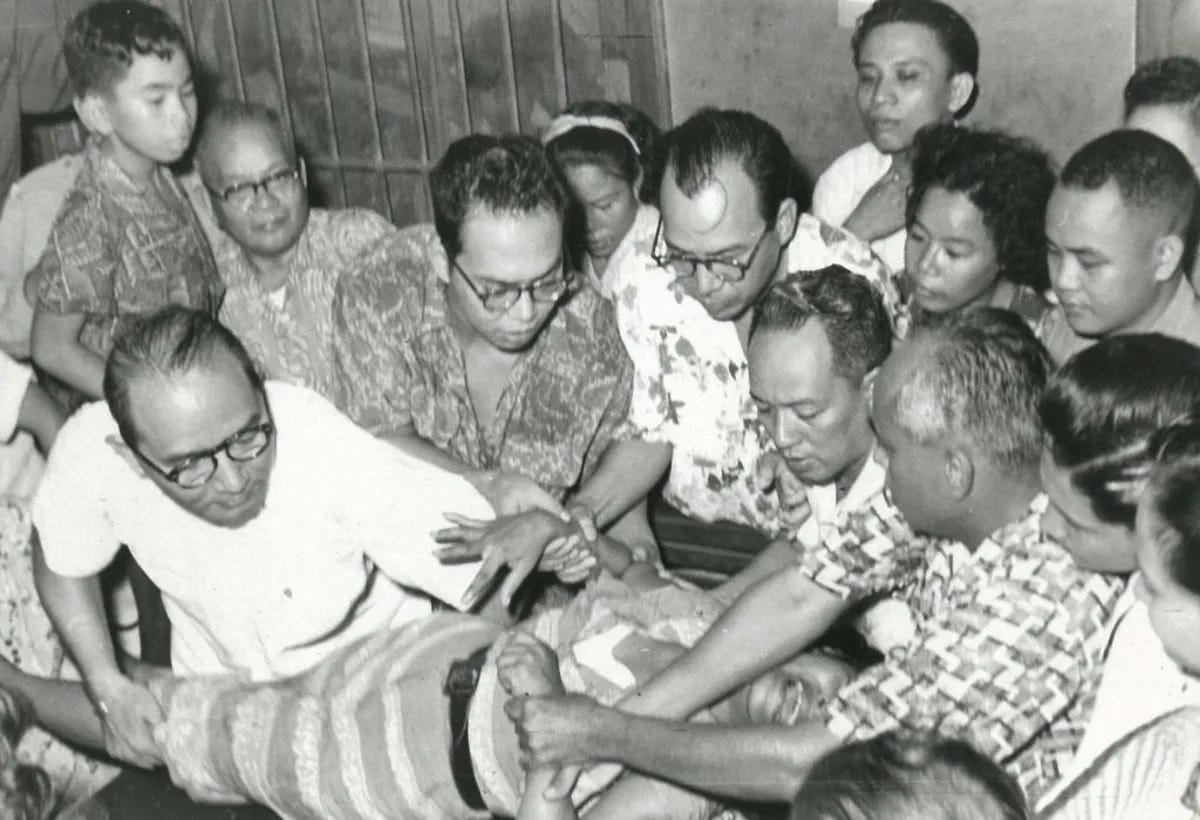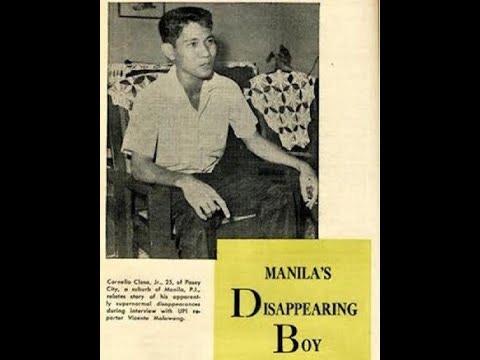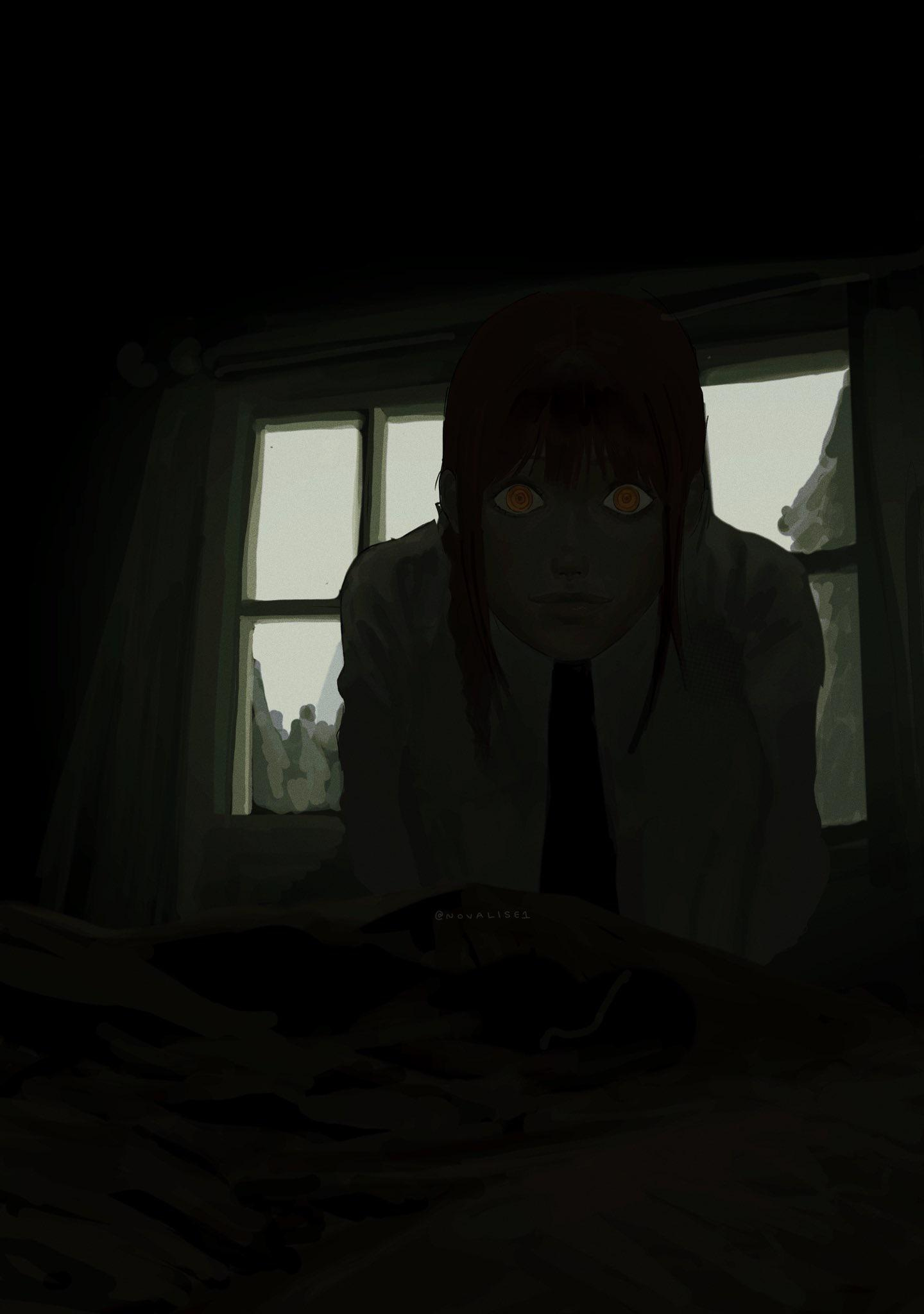The story of the invisible boy is true.
This is the opening line to Lester Sumrall’s bewildering personal account of a tale of the highest of high strangeness. The tale itself is one that has, for a variety of reasons, captivated me since I recently learned of it. It is an account of equal parts incredible fantasy and stark horror. In a way, it struck me as something of a modern fairy tale; a story in which the fantastical and whimsical lie in neat parallel to a subtle yet sinister undercurrent of unmistakable darkness, where a thin veneer of ethereal, otherworldly beauty obscures something much more disturbing.
This is the tale of Cornelio Closa.
Closa’s story is an obscure one. Were it not for the account provided by the aforementioned Sumrall, it’s doubtful that it would have ever left the island upon which it occurred, or even remained anything but a dark, weird, yet highly personal chapter in the Closa family’s history, only to be discussed in hushed tones in dimly lit rooms after perhaps one too many cervezas.
Sumrall is not the kind of man one would expect to tell a story like that of Closa’s experience. At least, not at first glance.
Born in the city of New Orleans, Lousiana in the year 1913, Sumrall was struck with a debilitating case of tuberculosis in his teenage years that nearly claimed his life. Only through the power of God and his personal faith, he claimed, did he persevere. Once recovered, Sumrall dedicated his life to spreading the good word of the gospel at the young age of seventeen. A devout pentacostal, he would strike out at age nineteen to do so and establish his own church in the small Arkansas town of Green Forest in 1932. In 1934, only two years later, Sumrall felt as though he had been called to preach the word of Christ elsewhere, and embarked on a mission to evangelize abroad. While Sumrall traveled extensively, trekking across almost every corner of the globe in his divinely inspired mission, he would find himself in the Philippines throughout much of the 1950’s. Particularly in the capital city of Manila.
In 1954, he would found the Cathedral of Praise in the city. Today, the church still stands, and with a congregation upwards of 24,000, is the single largest in the entirety of the Philippines. Members of his family still regularly preach there to this day.
During the church’s construction, in the year 1953, Sumrall would catch wind of a story that was sweeping across the city of Manila concerning the unusual incarceration of a seventeen year old woman named Clarita Villanueva. Forced by poverty into the world’s oldest profession, Villanueva had worked her way from a remote and rural village to Manila, where she claimed to be looking for a father she never met. While plying her trade to make ends meet, she offered her services to a plainclothes officer who promptly arrested the young woman on charges of solicitation.
On May 7th, 1953, Villanueva was taken to court, where, according to the testimony of witnesses, was suddenly possessed during the hearing. Over the following days, the young woman would lapse into fits of hysteria, thrashing about her cell, harming herself, and screaming that she was being assailed by unseen, demonic tormentors. Occasionally, she would fall into fits of deranged laughter, as well. Though the city of Manila was by far and away the largest in the country at the time, the various neighborhoods and communities were tight-knit and well connected. It did not take long for stories of the possessed woman to spread beyond the confines of the immediate locale and spread across Manila and beyond. The spectacle grew to such a magnitude that the then-mayor of Manila and well-respected politician, Arsenio Lacson, would personally visit her in prison, along with doctors, professors, and scientists from across the Philippines.
While seated next to her as she lied in bed, observers - including Lacson himself - testified that they saw physical bite-marks inexplicably manifest along Villanueva’s arm. Even though Villanueva only spoke the local tongue of Tagalog, she was apparently capable of speaking fluent English while possessed. All who witnessed the events testified earnestly that there was no logical explanation for the woman’s condition; it defied all conventional science and reason as they knew it.
Lacson would be far from the only one to observe this phenomenon. Mottled bruises would appear on Villanueva’s skin, seemingly of their own accord, and, at times, the phantom teeth would dig so deep into her flesh that they would draw blood.
A local doctor by the name of Mariano Lara visited her in her cell, as well, and reported that a pencil he had given her to sketch her demonic attackers was violently yanked from her hand by unseen forces. Reporters that attempted to inverview the woman claimed that Villanueva would, on occasion, seize up and become completely immobile. Even when pricked by needles, she would not move.
Interest in the case would swell far beyond Manila, the island of Luzon, and the Philippines itself, and would be printed in newspapers across the world. What began as simple, if morbid curiosity would evolve into a public panic after an account surfaced in which a doctor accused the young woman of faking the attacks. Villanueva, apparently, glared at the doctor and declared, You will die. She told the same to a prison guard, who reportedly kicked her as she attempted to attack him.
Not even a day after these statements were made, both men inexplicably dropped dead.
The worried public increasingly feared that Villanueva was not a hapless victim of demonic aggression, but rather a witch that possessed the infernal powers to curse and kill at her leisure. During the ordeal, over one-hundred medical and scientific professionals from the Philippines and abroad would investigate the case. One of which was Lester Sumrall.
Sumrall wrote the following in regards to his motivation in visiting the demonically stricken young woman;
I stayed up all night praying and weeping before the Lord. I was interceding for the city, for the girl and for myself. I was living in a city that had a great need and I was not helping to meet that need. I was so busy putting up our church building and doing my own thing that I was not involved in the tragedy of Bilibid1. The next morning God spoke to me and told me to go to that prison and pray for the demonized girl. I did not want to go, but God assured me that He had no one else in the city to send. Therefore I went.
With permission from Mayor Lacson, Sumrall would take it upon himself to conduct a form of Pentecostal exorcism known as a deliverance ceremony, with some cooperation with the previously mentioned Dr. Lara. After three days of intensive confrontation with Villanueva and her demonic adversaries, Villanueva would suddenly break from a violent fit of hysteria and simply tell Sumrall, He’s gone.
Afterwards, Dr. Lara and Sumrall would once again visit with Mayor Lacson to deliver the good news. According to Sumrall, upon entering the Mayor’s office, Lara would exclaim, My God, mayor. The devil is dead.
Sumrall, in turn, would correct the doctor. Mister Mayor, Sumrall said. Dr. Lara may be a good doctor, but he’s a poor theologian. The devil is not dead.
While the case of Clarita Villanueva would be highly publicized, particularly within the Philippines, much of the first-hand accounts and reports have been lost over the years. Sumrall’s account remains as one of the most comprehensive, as along with regularly referring to the incident in his preaching, he recorded it in his 1995 book, Alien Entities: A Look Behind the Door to the Spirit Realm. Again, while a Pentecostal pastor seems to be an unlikely candidate to write such a book, it is one of several that Sumrall wrote on the topic of the paranormal - none of which, curiously, are widely cited in lists of his extensive bibliography.
It seems that Sumrall’s experiences with the sinister and inexplicable were many. His observation that the devil is not dead proved to be particularly prescient; it would not be long before Sumrall would confront what he believed to be the devil in the Philippines again.
Before 1953 even came to a close, Lester Sumrall would meet Cornelio Closa Jr.
The month is September. The year, 1952.
On a balmy and warm late summer night, thirteen year old Cornelio Closa Jr. was walking home from Zamora Elementary School alongside a friend, Rudolfo Carmine, not far from the bustling heart of Manila. To save a bit of time, the two decided to cut through a large, open field, no doubt chatting about nothing in particular as they did. It might have taken Rudolfo a moment to notice that, after a few paces, he was walking alone, and the idle conversation had abruptly ended. Looking over his shoulder, Rudolfo saw Cornelio had stopped walking. He watched as his friend raised a hand and leveled a quaking finger towards something in the field. According to Rudolfo, his friend’s eyes were nearly bulging out of their sockets.
See the girl in a long white dress? asked Cornelio.
Rudolfo must have felt a pang of concern as he followed the direction of his friend’s pointing finger towards a spot in front of a dilapidated brick wall - most likely the last remains of a ruined building that once occupied the now empty field at some time.
She is beautiful, Cornelio told him. She is calling me.
Rudolfo gave the following account;
“I looked. I looked several times. As he approached the wall I saw him put out his hand and as he did I swear I saw Cornelio disappear from sight.”
And that’s exactly what happened - Cornelio had vanished. Suddenly, inexplicably, the boy had simply disappeared, as if deleted from existence. Rudolfo, now alone, did the only thing he could think to do - he fled. He ran until he was home, doubtlessly gasping for breath and standing on unsteady, quaking, and aching legs as he reviewed what he had seen in the theater of his mind. That night, he told no one of what he’d seen.
As I discussed this incident with my friends, they derided Rudolfo for both running from the scene and, worse, not telling anyone what had happened. This, I think, is a little uncharitable. If you were thirteen years old and you just happened to see your best friend wink out existence after telling you he saw some mysterious girl standing in the same field you’re also in, would you stick around to see what happened next? Because, personally, I think I’d probably break every record on the books for world’s fastest sprint to get my ass as far from that field as quick as my thirteen year old legs could get me. Even today, if I saw one of my friends just up and vanish right in front of me, I’d probably haul ass towards home so hard that I’d hurt myself, and then I’d be hard-pressed not to jump in my car, speed to the airport, and get the first ticket to anywhere that wasn’t where I just was.
One must consider that poor Rudolfo’s first thought was probably something along the lines off, My ass is gonna get grabbed next if I don’t get the fuck outta here.
And, you know what? I probably wouldn’t tell anyone what happened, either. Especially if I was thirteen. If a thirteen year old came up to you and started breathlessly explaining that their friend had just disappeared right before their eyes, would you believe them? You might not dismiss them out of hand, depending on how deep into the schizo pool you are, but I imagine most normal folks would probably not take an account that absurd at face value. And even if they did… what was anyone going to do about it? For all Rudolfo knew, Cornelio was gone gone. Never to be seen again. Ripped off the face of the map.
What was anyone going to do about that? Remove his consciousness out of the cosmic recycle bin it had been deleted to? Grab his ass out of the ether? This is assuming that the person you tell doesn’t have you sent on a full-ride scholarship to the Laugh Academy for even telling them you just saw someone vanish. The point is, I understand why Rudolfo didn’t breath a word of this to anyone until after the fact.
But this raises the question - what happened to Cornelio? Obviously, he came back to tell the story. Where did he go after vanishing from Rudolfo’s sight?
According to Cornelio, the girl in question was as mysterious as she was beguiling, and very much out of place. Cornelio described the girl as seemingly around his height and age, pale skinned and boasting long, blonde tresses that fell down around her waist. He claimed that she was so interestingly attractive that he didn’t even think to question her presence.
Now, I don’t know if you’ve ever seen a Pinoy before, but, while there are some stunningly beautiful Filipino women out there, most of them tend to have a bit… swarthier complexions than the average European.
And, I know, I know - the Philippines is a very diverse country with dozens of recognized ethnic groups that all have their physical differences, but blonde hair really isn’t a trait known to be particularly abundant among any of them. Or at all, really. So, this honey-blonde, lily-white kano2 was definitely going to stick out.
I suppose that there might have been some small possibility that this mystery girl was the daughter of some American expat that just so happened to be milling about a field in a spotless white dress on a random summer afternoon. After the U.S. acquired the Philippines as a war prize from Spain in 1898, Americans have not exactly been unknown to be found there, especially in a large, cosmopolitan city like Manila.
But this theory loses a lot of credibility when you take into account that Cornelio claimed that he noticed the girl’s bare feet were sloped down, and her toes brushed against the grass as she hovered off the ground. I think it’s safe to say that the alternative theory of just someone’s lost kid can be safely resigned to the trash can when one takes into account that, as when Cornelio cautiously approached her, she turned to look at him with a gentle, demure smile on her lips. She reached out for him and, in a kind, polite voice, asked, Please, go for a walk with me.
Without opening her mouth.
As Sumrall writes - Cornelio naturally consented.
Which is a great way of putting it because, yeah. Naturally a thirteen year old boy would consent to whatever a cute girl asked him to do. Even if she does communicate telepathically and has no right or reason to be where she is. Oh, and apparently defies gravity. Can’t forget that part.
Now, I’m sure you’re thinking to yourself, Why the fuck would you ever take up an offer like that? And, sure. That’s valid. That’s the reasonable thing to think in that kind of scenario. But, at the same time, Cornelio describes lapsing into an almost trance-like state at the very appearance of the girl. His higher functions were not working. So smitten, so charmed was he that he didn’t have the cognitive capabilities to look at her feet floating off the ground and react accordingly to the thought of, Well, that just doesn’t seem right.
And, even if he did stop and give that feature a once over… well, I’ve said it before. I’ll say it again. If I ever went on a hike and saw exceedingly fair and questionably beautiful maidens frolicking about the woods batting their feathery lashes and giving me come hither smiles…
Y’all wouldn’t ever hear from my dumb ass again.
And, on the off-chance you happen to be with me if such an event were to occur… don’t try to stop me. Just let it happen, man. To appropriate the last words of the late, great Ambrose Bierce’s final letter before his disappearance -
This is all to say - I don’t fault Cornelio for a second. I would have done the same damn thing.
When Cornelio made the understandable mistake of taking the girl’s hand, he reported that he felt… different. Light. Insubstantial, even. Almost as if his body had lost its weight. Rapidly, his awareness began to recede, and his surroundings became fuzzy and indistinct. He claimed that, the moment his fingers met hers, he felt himself bristle with energy before losing his senses entirely. What transpired afterwards, exactly, he claims not to know. As suddenly as it had all began, his wits and his memory returned to him, I imagine like a film starting up mid-scene.
The otherworldly girl had him in an gentle embrace. All at once, he felt substantial again. His body felt solid. He felt real. The girl pulled away, still smiling. He realized that he was standing at the front door of his home. It was dark, suggesting many hours had passed. If the girl said anything before departing, Cornelio made no mention of her parting words. She simply left him, and no sooner had she disappeared into the night did he realize just how tired he felt. He felt drained. Exhausted. He was hungry. Ravenously so. It was almost as if the life… well, it had been sucked right out of him.
All in all? Not bad for a first date. I mean, usually, blacking out the moment you meet someone and waking up at home with no memory of what happened or how you got there or who the fuck you were even out with is just about the worst way a date can end short of being stuffed in a body bag, but, believe it or not… I’ve had worse. I remember on my first date with one of my girlfriends we just spent half the time in my car staring at each other like -
But I digress.
Just like Rudolfo kept mum on what he’d seen with Cornelio, Cornelio likewise told no one about his mysterious dalliance with the otherworldly girl. Not that there was much to talk about, since, y’know - he couldn’t remember anything. It wasn’t until he reconnected with Rudolfo the next day at school that Cornelio even realized that something had happened, and the whole thing hadn’t just been some sort of bizarre fever dream, or perhaps a hallucination induced by the brutal tropical heat the Philippines is not unknown to have.
Needless to say, staggering into his family home well after he was expected to be there, bleary-eyed and exhausted, did not exactly go over well with Cornelio’s parents. Cornelio’s father, Cornelio Closa Sr., knew something was wrong with his son that very first night. Speaking to Sumrall, he said the following in regards to what happened upon Cornelio’s return home.
Of course, there’s nothing terribly out of the ordinary about a thirteen year old getting feisty and combative with their parents. It would have been easy for Cornelio’s parents to chalk his unusually combative behavior to the simple and natural urge for teenagers to act out, especially when they’re up to no good. Unfortunately for everyone involved, it was to become rapidly and explicitly clear that whatever had struck the mild-mannered Cornelio that night was not the average passing hormonal frustration of an antsy teenager. Unfortunately for Cornelio, as well, it seemed that whoever - or whatever - had spirited him away that September afternoon was not the type of girl that would be satisfied with a single night out. She was in it for the long-haul. Whether Cornelio consented or not.
The worst began with Cornelio’s behavior at school. A teacher only identified as Mrs. Agospi recalled to Sumrall that Cornelio developed a sudden interest in martial arts. And I don’t mean that Cornelio showed up the next day and enrolled in taekwando courses, or signed up for a membership at the local boxing gym; Cornelio showed up to school ready to throw down. The small and sleight Cornelio began to engage in fights with anyone willing to throw hands with him, which, given his newly-minted hair-trigger temper, was just about anyone and everyone who looked at him the wrong way. Mrs. Agospi claims that Cornelio would beef with three to four boys at a time and, despite his small stature and sickly disposition, manage not just to hold his own, but win. Mrs. Agospi told Sumrall that Cornelio had gone from a quiet boy to a nuisance, so much so that she lobbied with the school’s administration to have him removed from her class.
Not only would Cornelio come to school for the express purpose of laying the smack down on his peers, but his attendance became sparse. Several days, he would disappear from class, not to reappear until the following day. Other days, he would simply failed to show up at all. When notified of his son’s newfound obsession with the sport of hooky, Closa Sr. began to accompany his son on the way to school to ensure he got there. More than once, Closa Sr. said he would turn around and find that Cornelio, who only moments ago had been by his side, was no longer there. Again, I don’t doubt that Mr. Closa was under the impression that his son, truly dedicated to his new hobby of truancy, was just darting off and hiding the moment he was out of eyesight. But he and everyone else in Cornelio’s life were about to learn that the boy had not just become exceedingly efficient at the ancient practice of dodging the feds. Whatever was going on would not sufficiently be explained away by such mundane means.
Not all that long after Mrs. Agospi noticed Cornelio’s violent shift in disposition, she called him to the blackboard to solve a problem before the class. The teacher gave the following account to Sumrall.
He went to the blackboard, stood there for a few moments, and then simply evaporated.
This little vanishing act had exactly the kind of effect on Mrs. Agospi and her class that you would expect. What happened next is a bit unclear, but the long and short of it could be succinctly described as everyone in the room flipping a nuclear shit. I very much enjoy Mrs. Agospi’s comments on the event.
I decided before I lost my mind completely, I should resign.
The poor woman had to be thinking, I’m not getting paid enough to deal with this.
Again, it’s unclear whether or not Cornelio reappeared in class before her decision was made, or if the following event transpired when he learned that his disappearance had made his teacher resign, but Mrs. Agospi claimed that, whenever he did show up again, this happened.
Cornelio, for his part, said that the phantom girl would regularly appear, hand outstretched and smiling at him while in school. He claimed that, when she came, he had no choice but to accept her invitation to go on another walk. Now, if Cornelio was like any other thirteen year old of sound mind and body, it probably wouldn’t have taken much twisting of his arm to get him to ditch class. When I was thirteen, a phantom apparition of Muammar Gaddafi could have appeared to me while I was in class and said, Come with me, boy, we must construct the Pan-African state, and I would have just said, Say no more, Brotherly Leader and Guide of the Revolution of the Great Socialist People's Libyan Arab Jamahiriya.
Not because I like Muammar Gaddafi, or anything - I’m just saying that I would have taken any excuse to get out of Geometry or Pre-Cal, whether it came from a hot spirit babe or the ghost of a Libyan dictator.
Cornelio, however, claims that the only reason he went with the girl when she appeared during school hours was because, when she showed up, he would be overcome with a sensation he only described as strange, and the only thought left bouncing around his head like one of those oddly hypnotic Windows 95 screensavers was, Gotta go.
He described the act of vanishing as if it were stepping through a closed door as if it were open. The last thing he would recall before disappearing were the cries of shock from his terrified classmates and traumatized teacher. I just kind imagine him dematerializing right at his desk, accompanied by the Windows XP shutdown cue.
Now, maybe it’s just my distaste for mandatory, state-enforced, and institutionalized education - or just my general distaste for sitting anywhere for eight to ten hours straight - but I actually thought it was pretty cool of this weird spirit girl to be busting Cornelio out of the miserable doldrums of public school. Missing class and getting to hang out with cute, otherworldly girls? That’s a solid hook-up if I ever heard one.
But she wasn’t content to just take him away during the school day. In fact, she was increasingly not content to leave him alone at all.
Much less appreciable than springing young Cornelio out of elementary school was the girl’s nasty habit of not letting him sleep. You might be more on the fence about her behavior up until this point than me, but messing with a man’s sleep? That sends up a red flag no rose-tinted pair of spectacles could change the color of.
Cornelio described her nocturnal visits and the accompanying insomnia in truly horrific terms.
I don’t know what about that sounds more terrible - the itchy, burning clothes, sweating like a hog in the heat3 in bed, which always feels exponentially more gross than sweating anywhere else, or opening your eyes to find that chick just staring down at you like -
Even if she was cute, I’d have a hard time tolerating that. My beauty sleep is extremely important for me and everyone else around me, because if I don’t get it? We’re all gonna have a bad day. Also, I generally don’t appreciate being stared at while I sleep by preternatural entities, regardless of how easy on the eyes they might be. Or anyone, actually. That’s just - it isn’t cool.
But… it wasn’t all bad. At least for Cornelio. I mean, the girl was keeping him awake all hours of the night, which, as I’ve stated, is most definitely not very cash-money of her, but at least she didn’t wake him up just so they could stare at each other in the dark. As their, er - relationship, one might say, progressed, Cornelio began to recall more and more of what they would actually do while he was, to everyone else, vanished. Cornelio reported that, when she touched him, he, like her, would become intangible, capable of flight and moving through solid objects. The reason this case is sometimes dubbed The Peter Pan Possession is because, many nights, the girl would take Cornelio on fantastical expeditions across the city of Manila, flying alongside him over the bright, bustling city-scape.
Doesn’t that just sound… whimsical? Romantic, even? Gliding over a sprawling city, taking in the lights? Forget Peter Pan - that guy had zero game. Wendy was literally throwing himself at that guy and he was too concerned with bullshit like LARPing as a pirate and generally being an unproductive member of society to even notice. I get much more Aladdin and Jasmine vibes.
I guess the romanticism kind of depends on exactly how they were flying, since there’s a big difference between effortlessly gliding through the air like some sort of magic carpet and, uh…
That, I guess.
But this mystery girl wouldn’t just take Cornelio on spectacular and scenic night-time sojourns over the city. They’d go into it, too. Cornelio would recall the various activities the two got into.
They’d sneak into movies, which meant that Cornelio was getting to see all the hot new Filipino (and probably American) kino. For free. And after his bed time, too. I reckon he and the girl probably snuck into a few R-rated pics, wouldn’t you? I mean, the MPAA started rating movies in America in 1922, I bet the Philippines had their own rating system at the time. Given that the 1950’s were considered the Golden Age of Filipino Cinema, I bet they saw some real quality films, too.
Other times, they would go into restaurants to grab a quick bite. This also suggests that the girl could make them un-disappear when necessary, since I can’t imagine they could ordered while intangible. Cornelio did claim that, while they were out, no one seemed to notice them until she wanted them to be noticed. Now, I will say, if I were a waiter in the Philippines in the 1950’s - or anywhere at anytime, really - I’d probably have some questions if a pair of thirteen year olds showed up at my place of employment after sundown. Especially if one was a barefoot white girl who definitely didn’t look too Filipino. But, waiting tables is hard work, so I’d probably just take their orders anyway since their pesos would spend just as well as anyone else’s. Or they would… if the two actually paid. Apparently, this ghost girl would very conveniently make them disappear again, right after they got the check. Which is funny. Kind of a dick move to stiff on the tip, but also - still funny.
A handful of times, he and the girl landed and visited an international fair that was taking place in Manila, where they generally milled about, enjoyed the sites, and had fun in that sweet, innocent way that only a love-struck thirteen year old, untainted by the cynicism of adulthood and cold, hard reality, can really indulge in. It’s the type of love simply unknown to a thirty year old. Of course, he never explicitly says it was romantic, or that he ever felt in any way inclined to feel that way towards the girl, but, I mean… c’mon. She sounds pretty cool, doesn’t she? She’s hot, she’s taking him on airborne excursions, dining and dashing, watching R-rated movies, visiting fairs and probably doing a whole lot more fun stuff that Cornelio didn’t divulge or just didn’t remember because it really sounds like this ghost chick was screwing with his head, but… I’m just saying, if I was in Cornelio’s Filipino shoes, I would have been smitten as a kitten in Great Britain wearing mittens. Cupid’s arrow would have been buried so deep in my ass that whoever pulled it out would have been the King of England. Or the Philippines. Look, you get what I’m saying.
Or maybe I’m projecting. But why would I be doing that? I’m just saying, listen to this song and just imagine - and I really stretch those brain muscles, now - what these events might look like in some sort of montage from a charming traditionally-animated film might look like. You’ll get what I mean.
Do you see it? Do you understand my vision?
Well, if you didn’t… that’s a shame, and you’re wrong, but at least you got a good song out of it, because Panalangin isn’t just my favorite Original Pinoy Music track, but also just one of my favorite songs in general. Turns out the Filipinos were putting out some real high-grade fire back in the 70’s and 80’s. I would have never guessed, but I’m glad that I randomly found this song on Spotify one day. And now, I can share it with you.
You’re welcome.
Anyways, as nice as all that sounds, I probably don’t need to tell you that the reality of the situation was much less rosy, and, if this story was adapted to film, I could not rightly put Panalangin on the soundtrack.
The theme from The Exorcist would be more apropos.
As time went on, the girl’s visitations to Cornelio became more frequent, and their little walks together grew longer and longer. At their worst, Cornelio would be missing for three days, though he would be completely unaware of how long he would be gone during his phantasmal outings. More concerning, as he spent more time with the phantom girl, and their trips into the Manila nights became longer, he found that he increasingly remembered more and more of their interactions. The time he spent with the girl, once dream-like and surreal, began to feel more like reality, while reality felt ever-more like a dream. As if he was meant to exist alongside her, and that his waking life with his family, friends, and the rest of humanity, were annoying interludes between where he should have been. Cornelio claims that he eventually just began to stop doing anything. Eating. Sleeping. Seeing his friends. Talking to his family. Going to school, or even going outside. Instead, he would simply sit in his room. In the dark. And wait.
Wait for the luxurious dream of the beautiful, otherworldly girl to rescue him from what had become an intolerable life.
And make no mistake - Cornelio’s waking life was becoming intolerable. While Cornelio enjoyed the time he spent with the spirit girl, that was about the only time he did enjoy. Rapidly, his life in the physical, tangible world was unraveling. If his time spent with his friend, as he called her, was becoming his reality, than the real world was turning into a nightmare.
Remember how I said Cornelio’s behavior at school had taken a bad turn? Well, his behavior at home was gradually becoming even worse.
Cornelio’s mother describes his behavior thusly;
When she says that they practically imprisoned him at home, she isn’t exaggerating. Cornelio’s father, still believing that his son was afflicted with some sort of run-of-the-mill spurt of teenage rebelliousness, literally boarded his doors and windows shut at night. Yet, without fail, when he’d remove the nailed planks from the wall to check on the boy, he’d enter the room to find his bed empty, and his son nowhere to be found. Some nights, he’d simply go to bed, unsure of what to do and, really, helpless to do much of anything. Other nights, he’d sit in Cornelio’s room, wait for a while, but ultimately leave defeated and bewildered. Yet, he says that, in the morning - or, in some cases, days later - he’d check the room again to find Cornelio sleeping peacefully, with no rational explanation as to how he would have managed to return to his bed.
The only thing worse for the Closa family than Cornelio’s vanishing acts was what Cornelio did to them when he was around. He didn’t speak to his parent - he shouted at them.
He refused to eat. And when they did manage to get him to the dinner table -
He’d just smash the dish and sit there, glowering at them. He’d only eat when no one was looking, and only do so upon returning from his walks with the spirit girl, which he recalled would leave him starving and exhausted. One day in particularly, he raided the fridge with such ferocity that his parents came home to find it stripped bare of its contents, which Cornelio said, very astutely, was not helping my father’s blood pressure.
Eventually, in spite of his hunger, he found himself unable to stomach food at all. When he tried to eat, he’d find himself spitting out whatever he’d put in his mouth.
When no one was looking, he’d filch his father’s possessions and hide them around the house, including his house slippers, eyeglasses, wallet, and keys. Why? Just to be a pest, I assume. Or maybe something else was going on.
Cornelio makes it pretty clear that, for most of this time period, he wasn’t really in a right state of mind. He often expressed ignorance behind his motivations in his accounts. There’s a lot of I don’t know why’s or I had to’s. More than once, he even says that he knew what he was doing was wrong, and that he was deeply hurting the people around him, but was simply unable to overcome his base impulse to behave poorly as if he had no control over his own body.
The nadir would come when he would begin to steal money from his parents. And others. And, when confronted, Cornelio said he would fight back. Given the way he’d taken so naturally to brawling with schoolchildren, I can’t imagine he didn’t lay a few poor passersby out after they noticed he swiped their wallet. Once, when Closa Sr. confronted Cornelio, the boy reportedly leapt on his father like, as we used to say back in my middle school in a thick Southern drawl, like a spider-monkey.
Mr. Closa was at his wits’ end. With no other recourse, he finally turned to the last resort he’d most likely been considering during the series of these events, and prayed he’d never need to go through with; he sent his son to the funny farm. The loony bin. The booby hatch. Never heard that one? Neither had I until right now. We’re all learning something today.
At the mental institution - the name of which is not specified - the professionals were baffled by the story told by Closa Sr. I imagine he got the same response that most of us get when we go to the doctor these days, which tends to be something along the lines of, Well, shit. I’m stumped. Take some tylenol and get some rest. That’ll be five hundred dollars, please.
Cornelio simply says that, he wasn’t listening when they spoke to him. Not really surprising, that.
Afterwards, Mr. Closa realized he did have one other option. If Cornelio’s problematic behavior couldn’t be medicated… maybe it could be worked out with, er… brute force. Cornelio was taken by his father to what he described as an correctional institution for juvenile delinquents.
Apparently, Cornelio fought. With everyone. The other kids. The guards. The officials. He was about to make it clear that he wasn’t stuck in there with them - they were stuck in there with him.
I imagine it looked something like this.
How long Cornelio was in the institute for is not specified, but if I had to hazard a guess, I would assume it was somewhere between not long and a day. After becoming so belligerent that he needed to be tied down to his bed just to keep him from hurting others, the officials brought Cornelio back to his dejected parents’ home.
With no other remaining options, Cornelio said the following of his return;
My parents seemed to have resigned themselves to living with a monster.
By this point, Cornelio’s parents were certain that something untowards and unnatural was happening to their son. If the reports of their boy vanishing in front of the class weren’t enough to persuade them, nor the mysterious disappearances in which Cornelio would somehow Houdini his way out of a room with the exits boarded shut, what certainly confirmed their suspicions was an incident they reported to Sumrall. According to Cornelio’s parents, all of their children - Cornelio included - were gathered in the front room of the house while their mother prepared dinner. They said that the children were on the floor, playing with one another. Whether Cornelio was among them is unspecified, but, given his newly developed antipathy to everyone around him, I doubt he was. They also didn’t say what Cornelio’s father was doing, but I assume he was just chilling in an easy chair with the newspaper, or something. It doesn’t really matter. What does matter is that, apparently, in full view of the entire family, Cornelio just went - poof.
Gone.
Again - this went over about as well as you would expect. What made this particular incident even more egregious than the one he pulled in class was the fact that, as his parents recounted to Sumrall, the rest of the family began to cough, gag, and even retch from the intense stench left behind in his absence. Now, literally vanishing from existence with no practical explanation in front of your family is mean enough, but blasting them with a raunchy fart on your way out? That’s just cruel. As we all have experienced once in our lives, there’s nothing more rude than someone ripping ass and immediately dipping, leaving everyone else to suffocate in their wake.
All jokes aside, though, vanishing in a puff of unholy stank is something distinctly demonic, so, if it isn’t becoming clear exactly what’s happening at this point… well, don’t worry. It will get completely copacetic soon enough.
This episode in Cornelio’s life, if we could call it that, lasted for over a full calendar year. A full year of inexplicably vanishing. A full year of unhinged, out of pocket behavior, stealing, brawling, and generally raising Hell. Apparently, even the fumigation move was not a one-time incident. For an entire year, Cornelio lived in a waking dream in which Manila was his oyster, handed to him by his blonde manic pixie dream gringa, while his parents and family suffered. During that year, Cornelio’s histrionics would set the rumor mill in Manila ablaze with gossip. After all, a kid just blinks out of existence in front of a room full of kids and drives his teacher to retire, right then and there? People are gonna talk. Stories of the disappearing boy of Manila would begin to spread. Soon, Cornelio was an urban legend in his own right. Feared by his neighbors. Feared by his family. One can only imagine the ridicule and ostracization they experienced.
During this time, however, the story was not making many headlines. For obvious reasons, Closa Sr. did not want it to. Sumrall relates that Mr. Closa was a wealthy man. By then-current Filipino standards, he's careful to mention. Mr. Closa was a Filipino citizen, but served with the United States Navy in an unspecified capacity. At the time, it was not uncommon for citizens from what were considered third-world nations to serve in the Navy - especially those from the Philippines, due to the two nations’ close relations and colonial history. When Mr. Closa retired, he did so with a U.S. Navy pension, which made him, by the nation's standards, a relatively well-to-do man. Sumrall states that the family lived in a large, beautiful house in Manila, in an upscale neighborhood, and only by virtue of hiding Cornelio away behind the gates of their home (and perhaps Closa Sr.’s connections with members of the local press) did the family manage to keep the story of their vanishing boy from spinning entirely out of control into a full-fledged media spectacle the same way the story of Clarita Villanueva did.
However, things finally began to change for the better the day Cornelio’s father just happened to bring a friend over to the house for lunch. This man was not just a friend, but a business associate. He also happened to be a Methodist pastor. I don’t doubt that Cornelio was busy being just the worst while this guy was trying to eat, as he does say, I was sure my father was very displeased at the way I was behaving in front of his friend.
I also have to think that, as a Methodist pastor, this guy looked at Cornelio and just got the distinct feeling that the boy wasn’t quite right. Cornelio said that the man looked at him for a long time. Cornelio scowled back. As he did, he claims that he could hear an evil laugh coming from outside. He knew what it was. He said, and I quote, It was the alien entity, though I doubt he thought of it as such in the moment. When the laughter subsided, he heard something else - a familiar, pleasant voice inside his head, now speaking with uncharacteristic urgency. It was the girl. His friend.
And she was telling him that he needed to run away.
Why didn’t he? Before, he’d been unable to control his impulses. Yet, this time, he remained where he was, despite the insistence by his friend that he needed to flee. Stranger still, if his friend could spirit him away at any given moment, simply pull him right out of reality and into her waking dream… why didn’t she come for him while he was in the presence of a man of God?
The pastor told Closa Sr. that his son was in extreme danger. He needed help. Badly. He needed to be prayed over, and immediately. Much to Mr. Closa’s relief, he also told him that he knew someone who could help. Someone who had already helped others. And perhaps the only person who could help Cornelio.
But not before telling Cornelio this -
According to Sumrall, what Cornelio would later describe as a frightful dream began in 1952 and into 1953. This was the same year that Sumrall had endeared himself to the people of Manila when he resolved the possession of Clarita Villanueva. In fact, Villanueva had been freed from her ordeal in May of that year. If Sumrall’s time frame is accurate4, Cornelio’s first encounter with the mysterious girl was in September of the same year, only scant months later. The devil was not dead, as Sumrall had so aptly told Mayor Lacson - he’d just found a new toy.
When alerted to the case, Sumrall took an immediate interest in it. Sumrall himself embarked on a rigorous interview campaign, gathering statements from Cornelio’s parents, neighbors, friends (including Rudolfo Carmine), as well as his erstwhile teacher, Mrs. Agospi, who he says had suffered such a tremendous mental breakdown in the aftermath of Cornelio’s vanishing that she never returned to teaching. They all swore that the stories were true. Many testified that they, too, had seen Cornelio disappear. Sumrall hired investigators in Manila to track down witnesses. He even hired police officers to deliver and collect the witnesses official and legally valid affidavits - which they all signed - swearing that they had told the truth, the whole truth, and nothing but the truth. An American reverend, H.A. Baker, even traveled to the Philippines at Sumrall’s request and did his own inquiry, interviewing witnesses, Mrs. Agospi, Cornelio’s parents, and even Cornelio himself. Again, Reverend Baker came to the same conclusion as Sumrall - whatever was happening, it was real.
Cornelio’s parents, as well as the Methodist pastor, would take the boy to meet with Sumrall in his newly finished Cathedral of Praise. Immediately, Cornelio felt uncomfortable. Antsy. Like he had to escape. I imagine he might have tried, if not for the sudden appearance of his friend. She was standing outside of the church, just beyond the front door and peering through the glass. And she was not happy.
I imagine that, at this point, Cornelio realized just how deep in the proverbial shit he really was.
Inside the church, the pastor brought Cornelio to Sumrall. I enjoy this little exchange between the two, which comes from Cornelio’s own testimony.
It reads like actual dialogue from the Bible.
Compared to the rest of the story, the ending is quite anti-climactic; there is no crescendo of insanity as Sumrall prays over the demon-afflicted boy, where chairs start flying around the room or windows shatter into glass shrapnel. There is no moment where Cornelio transforms into some ghoulish goblin and starts skittering across the ceiling or twisting his head around like an owl. Real exorcisms, from what I understand, are quite tame in comparison to Hollywood exorcisms, which is something I think we - and especially people like Cornelio - can be grateful for. Sumrall and Cornelio both claim that, after an session of intense prayer together, Cornelio simply felt as if the darkness that had plagued him for over a year was gone. His erstwhile friend never returned.
Though, you just know that if they ever make a Conjuring movie based on this case (and I say based very lightly), there’s gonna be a scene during the exorcism where she, like, crawls out a vent duct, suddenly very tangible and visible to everyone, and Hulks out into a red-skinned giga-demon that mercs a pastor or two before Ed and Lorainne Warren cross their proton pack streams and zap it.
As for what happened to Cornelio Closa Jr. in the aftermath of all of this… I’m not entirely sure. Sumrall, in his recountings of the story, never goes into much depth about it and just says that he’s now saved by the spirit of Christ and a good, church-going, law-abiding, not-demonically-possessed guy. As mentioned before, Cornelio himself obviously grew up to be just fine since he was giving interviews to the Filipino press as an adult, but if he spoke about his later life, I couldn’t find any sources in English about it. Whatever the case may be, I hope he lived - or likely is living - a happy, fulfilling life. I also sincerely hope his friend never came back to invite him on another midnight dalliance and, on the off-chance she did, one should wish that he learned his lesson about wandering off with blonde-haired gringas that hover around places where they shouldn’t be.
Now, this is where I have to address some… inconsistencies in the narrative. According to some sources - and the way Cornelio makes it sound in his own interviews - the pastor brought Cornelio to Sumrall and it was all resolved that day in short order; a real wham, bam, thank you, ma’am affair that evicted the devilish specter right then and there. This conflicts with Sumrall’s own account, which suggests that he was already aware of Cornelio’s plight by the time he was brought to the Cathedral of praise, and had already conducted his extensive interviewing of the witnesses.
There are multiple sources I’ve taken into account for this story. Many internet articles and pieces written for paranormal-centric blogs about this case reference the retelling of the story in Brad Steiger’s book, The Awful Thing in the Attic, in which is it one of several incidents the author writes about. While I did use some of these articles as research, I did not read Steiger’s book.
Rather, I read Sumrall’s personal account from his own book, Alien Entities: A Look Behind the Door to the Spirit Realm. Given that one is a first-hand account, and the other based on third-party sources, it’s only logical that there will be inconsistencies between the two. This is a problem that arises quite frequently in the study of the paranormal; as I discussed in my piece on the Sandown Clown, it is incredibly easy for crucial details to be omitted and misunderstanding or misconceptions to be presented as fact when the story is told time and time again, even when there is a primary, first-hand source that all others stem from.
Almost all of the information about this case - at least in the West - are drawn from Sumrall’s book and preaching.
While I can’t make the claim that Steiger drew on Sumrall’s account for the bulk of his writing on the topic, as I didn’t read it, I’ve seen others say that Steiger used media like newspaper stories to gather information on he case. This would explain the confusion in the timeline between the two. Steiger gives the events a time frame of 1953 and 1954, while Sumrall dates the beginning of Cornelio’s troubles in 1952 and ending in 1953. This made it very difficult to cobble together a narrative using sources based on both Steiger and Sumrall’s accounts. It’s also worth noting that, according to the sources I’ve read on Steiger’s account, Steiger makes a passing mention of Sumrall as a curious onlooker who studied the case, but played no major part in its resolution. Apparently, Steiger claims that it was Cornelio’s time at the mental facility that cured him of his trouble - no exorcism needed. This, for obvious reasons, makes reconciling the two conflicting narratives somewhat troublesome.
Now, I believe the reason many online sources cite Steiger’s book more regularly than Sumrall’s first-hand source is because the former is a very prominent figure in paranormal circles, and his books much easier to find and acquire than Sumrall’s. You can get a copy of The Awful Thing in the Attic for less than ten bucks on Amazon from a litany of sources. On the other hand, Sumrall’s book fetches a price of forty dollars for a used copy5, which is carried by far fewer retailers. Though, I’d also add that you can hear Sumrall recount much of the story (albeit in slightly less detail) for free on YouTube, where pretty much all of his televised sermons have been posted by his followers6.
I only say this to not only reiterate the difficulty of studying the paranormal, and why almost anything you read about it should be taken with measured skepticism, but also because if you choose to look into Cornelio’s ordeal yourself, you’ll find a lot of conflicting information. Steiger, though very well respected by researchers of the paranormal, was not unknown to allegations from his contemporaries and peers of coloring the truth and having a poor track record of citing his sources. I say this not to disparage the man, but for the sake of remaining objective. This is why I’ve relied mostly on Sumrall’s own account, since he was, apparently, there to see it himself. If it happened.
Which we must ask - did it?
Like any case of high strangeness, it’s impossible to tell. The witnesses and victims have their stories and they’ve stuck to them, and attempting to validate whether or not their accounts of truthful is a fool’s errand. All we can do is listen, speculate on the information we’re given, and draw our own conclusions.
Personally, I am, as I often am with stories such as Cornelio’s encounter with the infernal, on the fence. I’ve seen some of what few others have studied the case say that there is a logical reason to doubt. Some say that Sumrall could have developed the story a sensational means of publicizing his church in Manila and boosting his reputation with the locals. Others say that Cornelio himself could have very well played along with it for attention and fame. Some think that there may be truth to the story, but the more fantastical details were embellished by one party or the other for the sake of making the account more exciting and dramatic. I do see the logic in this thinking. I don’t know if I agree, but it makes sense. If the legal paperwork that Sumrall claims was collected during his research - affidavits signed by witnesses, so on and so forth - that would go a long way to validate his side of the story. Unfortunately, if they do or ever did exist, we’ll most likely never see them.
Taken as it is, though, the account of Manila’s vanishing boy is one of the most beguiling stories of the preternatural I’ve come across; one that is equal parts fantastical, amazing, at times humorous, but deeply disturbing and haunting in its implications. True or not, if you take anything from this tale, let it be this - if you ever happen to see a girl of unearthly and ethereal beauty milling about by her lonesome, make sure her feet are firmly on the ground before you take her up on an offer to stroll around the block.
You never know where she might take you. And you never know if she’ll decide to bring you back.
This is an article that I wrote back in October, during my month-long paranormal deep-dive series. It remained unfinished for a while as I waited on Sumrall’s book to come in (I also wrote the equally long article about the Cottingley Fairies and two back-to-back hefty reads seemed a bit much), and eventually fell on the backburner, though a good friend of mine with an interest in these types of things has been pushing for me to publish it, so here it is, Hunter. Apologies for the delay.
Now also seemed like a good time to publish it since my free time has been almost non-existant due to working a new second job (by choice, not necessity) and other obligations that have kept me from the writing desk.
Rest assured that the shitposting will continue.
If you made it this far, I truly appreciate your time, and I sincerely hope you enjoyed what you read.
Bilibid refers to Bilibid Prison, where the woman was incarcerated during the ordeal. Bilibid was established in 1865 by the then colonial powers of Spain and has been continuously in operation since. Infamously, the prison was used by the occupying Japanese military as a camp for prisoners of war. Today, the prison is known as the Manila City Prison, and is one of the most overcrowded prisons on the planet.
A Tagalog term for white foreigner, stemming from Ameri-can.
Yes, I know, I know - pigs don’t sweat.
Different sources give different time frames, but I’m using the timeline laid out by Lester Sumrall in his book, which serves as the definitive and first-hand account of the story.
I was lucky and managed to get a copy for twenty-five, which tells me I probably got the last “cheap” one.
There’s also a documentary about the incident that Sumrall produced that muddles the timeline further, so I did not watch it and tried to avoid articles that seemed to use it as their chief reference.





















What a wonderful tale.
Fantastic and well written too!
Love your work, keep it up and i hope to read more in the future.
This has been a great series. Absolutely fascinating tale. Thanks, YA!